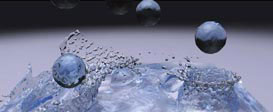Courses Fact Sheet
Chair: Matt Adcock, Commonwealth Scientific and Industrial Research Organisation
Conference: Wednesday 10 December - Saturday 13 December
Exhibition: Thursday 11 December - Saturday 13 December
The Facts
- The SIGGRAPH Asia 2008 Courses programme provides invaluable learning opportunities in three formats: tutorials, half-day classes, and full-day courses. Attendees will learn principles and techniques from leading international experts, who present instructional sessions on a comprehensive range of computer graphics and interactive techniques: animation, modelling, rendering, software development, computer-human interaction, entertainment, gaming and scientific visualisation.
- SIGGRAPH Asia 2008 will feature a special, limited-space, hands-on course on Pixar's award-winning RenderMan rendering system.
- The Courses programme provides a unique opportunity for students, educators, and professionals to acquire or reinforce their knowledge of important topics.
A Quote from the SIGGRAPH Asia 2008 Courses Chair:
"The submissions we received were of an excellent standard, and the courses jury had some really hard decisions to make. We have a wonderfully diverse and enriching slate of courses for the inaugural SIGGRAPH Asia conference. It will really appeal to attendees from the Asia and also draw people from around the globe. SIGGRAPH Asia 2008 is the place for students, academics, artists and practitioners to take the next step in developing and honing their skills."
SIGGRAPH Asia 2008 Courses highlights include:
Pixar's RenderMan
This full-day course is an intensive, hands-on practical introduction to Pixar's RenderMan, a high-quality renderer that is widely used in the animation and digital effects industry.
Malcolm A. Kesson
Savannah College of Art and Design
Developing Augmented Reality Applications
In this course, attendees learn how to use open-source software to build their own augmented reality (AR) applications. As computers become more and more invisible, AR (overlaying virtual images on the real world) is becoming an increasingly important application area for computer graphics and user-interface design. This detailed introduction to AR interface design and research includes reviews of important topics such as tracking and registration, interaction techniques, design principles, and usability evaluation, as well as key areas for current and future AR research. Case studies are presented in the application areas of gaming, entertainment, medicine, and engineering. Part of the course also involves hands-on demonstrations where attendees will be able to experience the technology for themselves.
Mark Billinghurst
Raphaël Grasset
Human Interface Technology Laboratory New Zealand
There Can Be Only One: Independent Animation for the Lonely
Attendees learn pre-production concepts and techniques that will allow them to focus on creative aspects of their projects and avoid time-consuming scheduling mistakes that can cripple production. From concept to design, storyboard to animatic, attendees learn the smartest ways to work and how to save time, money, and heartache as they seek to realise their unique visions. Scheduling, resource management, and copyright issues are explored and discussed in the production segment of the course, to keep the artist on track for project completion while taking care of minute details that could lead to major legal and logistical roadblocks. In the post-production segment, the final edit, output issues, credits, DVD authoring, making press kits, and final submission to animation festivals are addressed, giving attendees a clear, organised plan of creation and production. With more careful organisation, animators can concentrate on the creative aspects of their work and not get bogged down in unforeseen details.
Kristen Palana
The American University of Rome
Steve Rittler
William Paterson University
Modern OpenGL: Its Design and Evolution
A long-time implementer of OpenGL and the system's original architect explain OpenGL's design and evolution. OpenGL's state machine is now a complex data flow with multiple programmable stages. In this course, OpenGL practitioners can expect candid design explanations, advice for programming modern GPUs, and insight into OpenGL's future.
OpenGL was conceived in 1991 to provide an industry standard for programming the hardware graphics pipeline. The original design has evolved considerably over the last 17 years. Whereas capabilities mandated by OpenGL such as texture mapping and a stencil buffer were present only on the world's most expensive graphics hardware in 1991, now these features are completely pervasive in PCs and are even available in several hand-held devices. Over that time, OpenGL's original fixed-function state machine has evolved into a complex data flow including several application-programmable stages. And the performance of OpenGL has increased from 100x to over 1,000x in many important raw graphics operations.
This course explains how the modern (post-2006) graphics hardware pipeline is exposed through OpenGL. Kurt Akeley presents his personal retrospective on OpenGL's development. Attendees learn nine ways to write better OpenGL programs and how modern OpenGL implementations operate. In conclusion, the course assesses OpenGL's future evolution.
Whether you program with OpenGL or program with another API such as Direct3D, this course gives you new insights into graphics hardware architecture, programmable shading, and how to take maximum advantage of modern GPUs.
Mark Kilgard
NVIDIA Corporation
Kurt Akeley
Microsoft Research Silicon Valley









